| Lesson 5 | Logic within queries |
| Objective | Practice writing logic within your queries. |
Logic within Queries of SQL-Server 2012
Many times in your SQL procedures you need to test the value of a variable, then take some action based on that value.
You can do this with SQL Server’s Transact-SQL control-of-flow logic. Control-of-flow logic is a specific set of Transact-SQL commands that you can enter into your Transact-SQL procedures to dynamically control which statements are executed.
The following is a list of the keywords available in Transact-SQL:
You can do this with SQL Server’s Transact-SQL control-of-flow logic. Control-of-flow logic is a specific set of Transact-SQL commands that you can enter into your Transact-SQL procedures to dynamically control which statements are executed.
The following is a list of the keywords available in Transact-SQL:
BEGIN…END– Defines a block of Transact-SQL codeGOTO– Instructs the processor to go to a specific label defined in the procedureIF…ELSE– Tests for conditions that you specify. The results of these conditions always return values of TRUE or FALSE. As such, they are known as Boolean expressions.RETURN– Exits the procedureWAITFOR– Delays the execution of a statement until specific conditions existWHILE– Loops until a specific condition existsBREAK– Unconditionally exits aWHILEloopCONTINUE– Restarts theWHILEloopCASE…WHEN– Tests multiple possibilities for a given condition
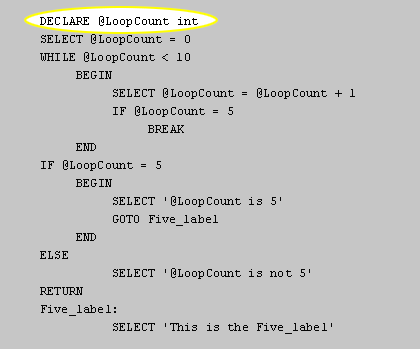
DECLARE @LoopCount int
SELECT @LoopCount = 0
WHILE @LoopCount < 10
BEGIN
SELECT @LoopCount = @LoopCount + 1
IF @LoopCount = 5
BREAK
END
IF @LoopCount = 5
BEGIN
SELECT '@LoopCount is 5'
GOTO Five_label
END
ELSE
SELECT '@LoopCount is not 5'
RETURN
Five_label:
SELECT 'This is the Five_label'
This script initializes a variable, loops with a WHILE statement, breaks when a condition is met, uses conditional statements, and includes a GOTO to jump to a label.
1) @LoopCount is declared as an integer variable that will be used in the rest of the statement
Revised Code for SQL Server 2022 Compatibility
The given Transact-SQL code outline above would not execute successfully in SQL Server 2022 as-is due to the following reasons:
Changes Made:
Execution in SQL Server 2022
The revised code will execute successfully and produce the following output:
If the `Five_label` is missing or incorrectly formatted, the code will still fail in SQL Server 2022. Ensure the entire block, including labels, is present.
-
Incorrect Use of SELECT for String Literals
- Statements like
SELECT '@LoopCount is 5'andSELECT '@LoopCount is not 5'are attempting to use single quotes (') to denote string literals. While this syntax itself is valid, the intention might be to display the string value rather than execute a SELECT query that returns a string literal. - If the goal is to print these strings, use the
PRINTstatement instead:
PRINT '@LoopCount is 5'
- Statements like
-
Missing
Five_label- The label
Five_labelis referenced in theGOTOstatement but is not defined in this snippet. Although your earlier image containsFive_labeland its definition, this specific code block does not include it. - Without the definition of
Five_label, SQL Server will raise an error:
Incorrect syntax near 'Five_label'.
- The label
-
RETURN Statement
- The
RETURNstatement is valid in Transact-SQL. However, it must be followed by an optional integer value or simply terminate the execution of the batch. In this case,RETURNis unnecessary for this logic unless it is part of a stored procedure or a function.
- The
DECLARE @LoopCount int;
SET @LoopCount = 0;
WHILE @LoopCount < 10
BEGIN
SET @LoopCount = @LoopCount + 1;
IF @LoopCount = 5
BREAK;
END
IF @LoopCount = 5
BEGIN
PRINT '@LoopCount is 5';
GOTO Five_label;
END
ELSE
PRINT '@LoopCount is not 5';
RETURN;
Five_label:
PRINT 'This is the Five_label';
Changes Made:
Execution in SQL Server 2022
The revised code will execute successfully and produce the following output:
@LoopCount is 5 This is the Five_label
If the `Five_label` is missing or incorrectly formatted, the code will still fail in SQL Server 2022. Ensure the entire block, including labels, is present.
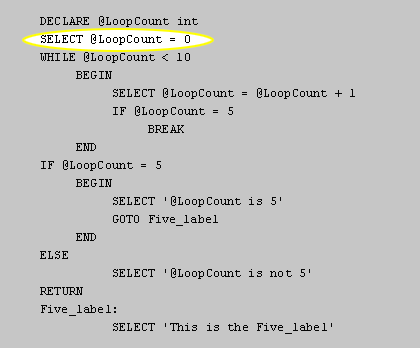
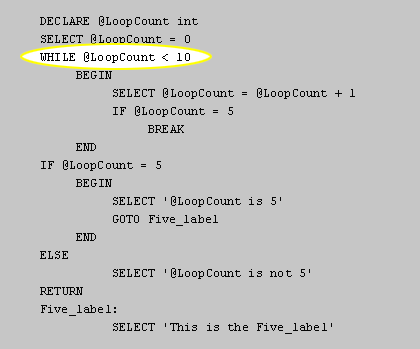
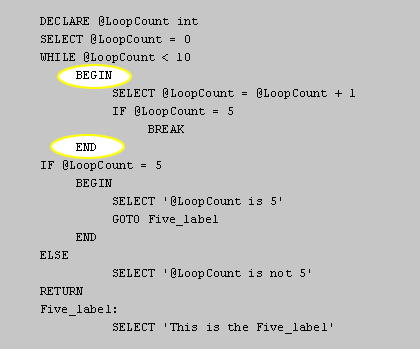
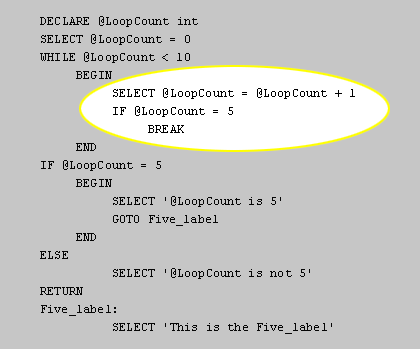
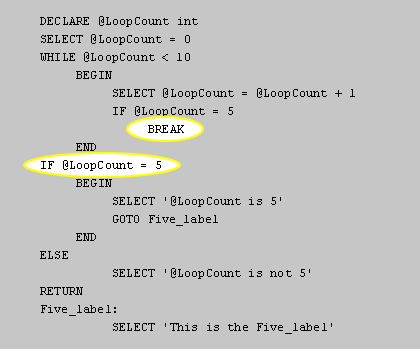
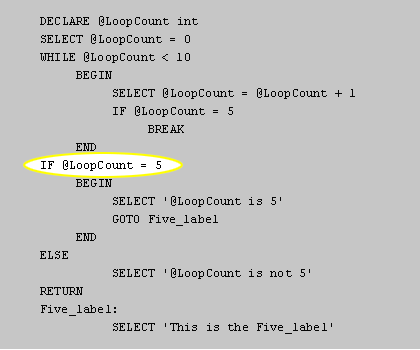

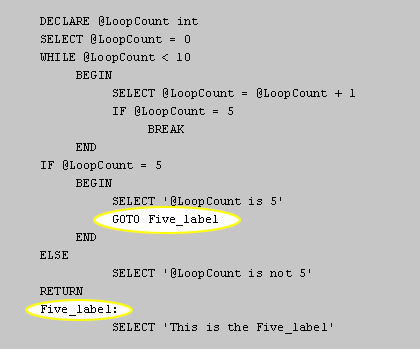
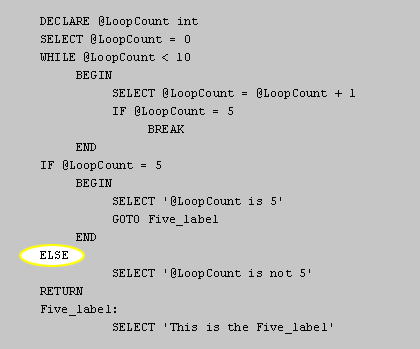
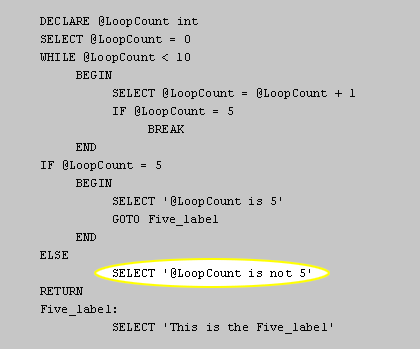
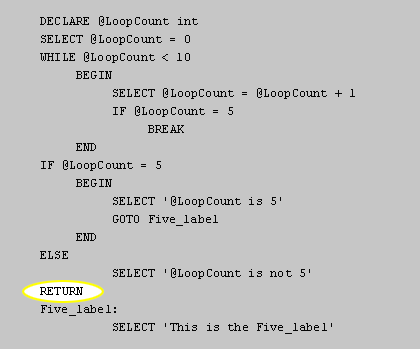
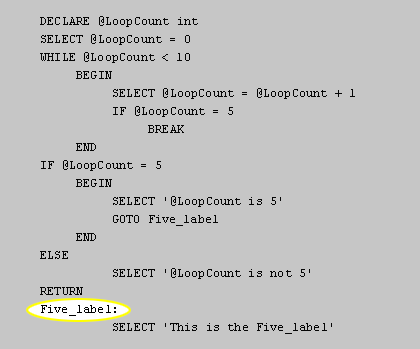
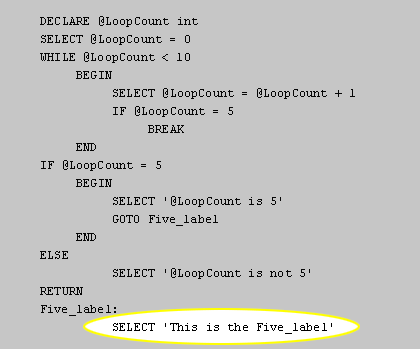
Using While Statement in SQL-Server
This SQL Server tutorial explains how to use the WHILE LOOP in SQL Server (Transact-SQL) with syntax and examples.
In SQL Server, you use a WHILE LOOP when you are not sure how many times you will execute the loop body and the loop body may not execute even once.
WHILE condition
BEGIN
{...statements...}
END;
-
Parameters or Arguments
- condition: The condition is test each pass through the loop. If condition evaluates to TRUE, the loop body is executed. If condition evaluates to FALSE, the loop is terminated.
- statements: The statements of code to execute each pass through the loop.
- You would use a WHILE LOOP statement when you are unsure of how many times you want the loop body to execute.
- Since the WHILE condition is evaluated before entering the loop, it is possible that the loop body may not execute even once.
- See also the BREAK statement to exit from the WHILE LOOP early.
- See also the CONTINUE statement to restart the WHILE LOOP from the beginning.
Note that the
SELECT statement is covered in a later lesson in this module.
The main point of this lesson is to show the structure of how to use logic in your queries. The actual SELECT statements shown are not significant. In the next lesson, the benefits of constructing SQL statements dynamically will be discussed.
Logic with Queries - Exercise
Before moving on to the next lesson, click the Exercise link below to practice writing query logic.
Logic within Queries - Exercise
Logic within Queries - Exercise